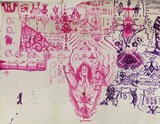>>40893735
The cult of Sabazios was orgiastic in nature; the participants in the festivities in honor of Sabazios danced with snakes in their hands, depicting the mystical union of Zeus and Persephone. From the 4th century. there is evidence from the orator Demosthenes about the method of publicly honoring Sabacia, in which Aeschines, together with his mother, took part more than once. These were street orgies, day and night, accompanied by loud, disorderly singing, noisy music on cymbals and kettledrums, and peculiar, too free dances. The participants in the procession (thiasos) decorated their heads with dill and poplar leaves, covered themselves with the bloody skins of young deer, clutched thick snakes in their hands and shook them in the air, and, having performed the ritual of purification with water, clay, and bran, said: "I fled from evil and found good"; In the daytime processions, exclamations were heard: ευοϊ σαβοϊ, ϋης άττης, άττης ϋης; the leader of the procession, the old women, was rewarded with various pastries made of flour and honey with raisins. The most important act in the initiation of novices into the mystery was the passage of a snake through the clothing of the initiate, with the snake sliding down the chest to the feet, as if symbolizing and recalling the love affair of Zeus and Persephone. According to the description of Strabo, the same rites were observed in the Phrygian cult of Sabasia. The most unbridled sexual relations and carousing of men and women constituted one of the accessories of these orgies. According to the assurance of the priests of Sabaius, human souls received purification and remission of sins in the mysteries of the deity. There is, moreover, reason to suppose that in the mysteries of Sabaius, as in the Eleusinian mysteries, the initiates perceived indications of the immortality of the soul: in the cult and prayers it was marked by the death and rebirth of Sabaius.
4chan Search
2 results for "ca7de282617f370a523c4a73a7a2323f"
>>40890802
have i shown you my art i made 8yrs ago
ma'at signed it herself and was my teacher
she says i can call her anytime 9999 9999 9999 9999
have i shown you my art i made 8yrs ago
ma'at signed it herself and was my teacher
she says i can call her anytime 9999 9999 9999 9999
